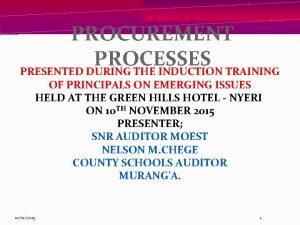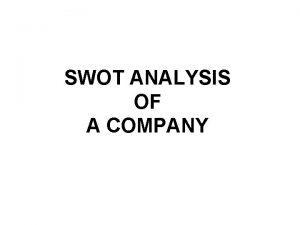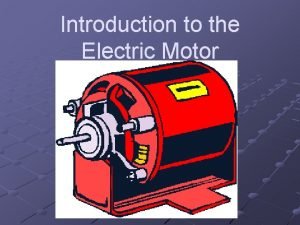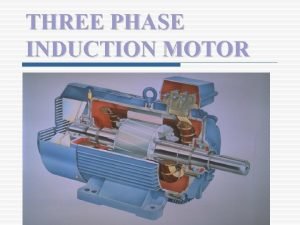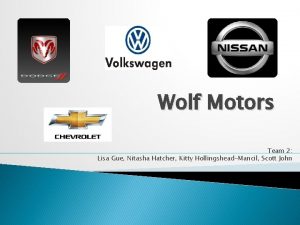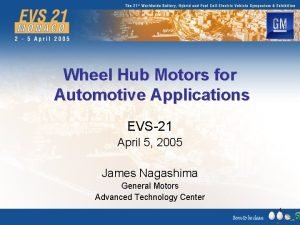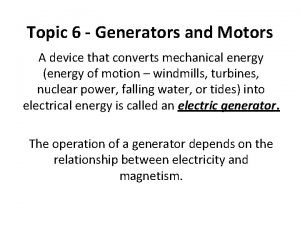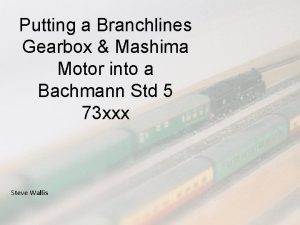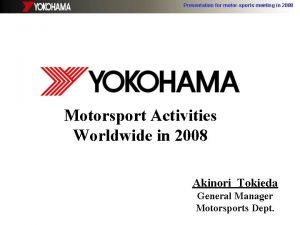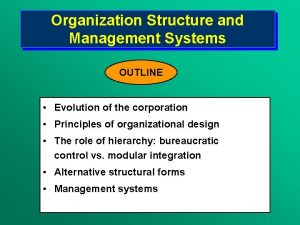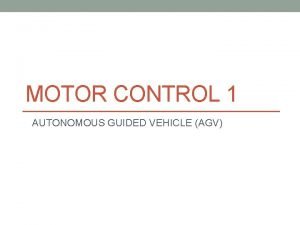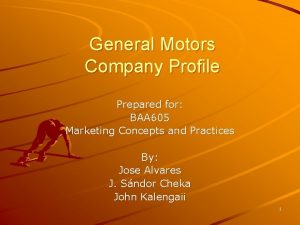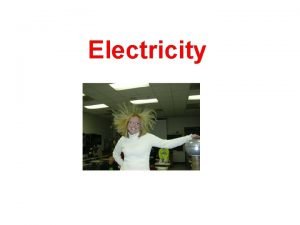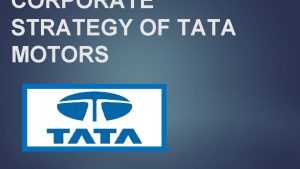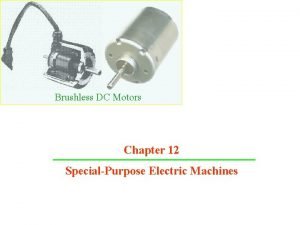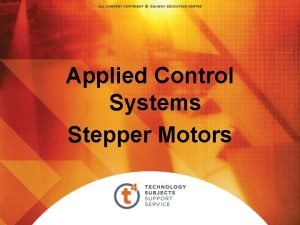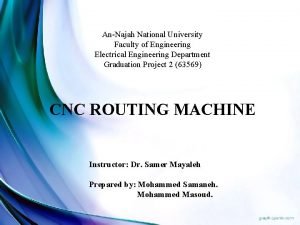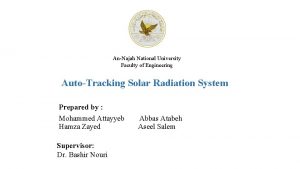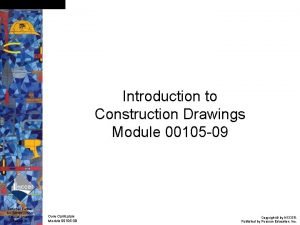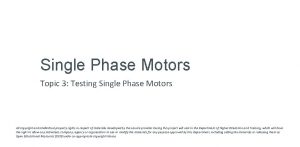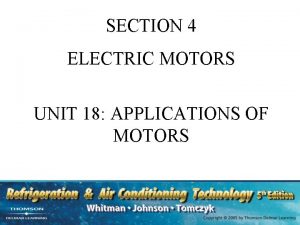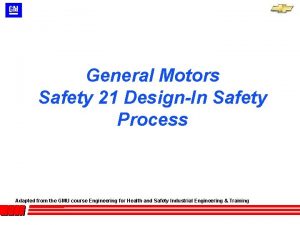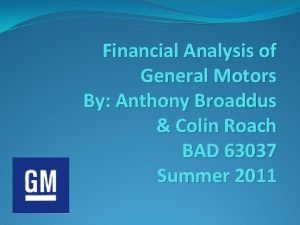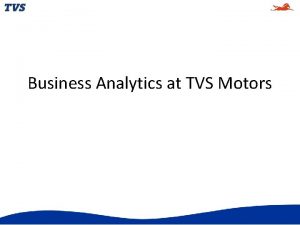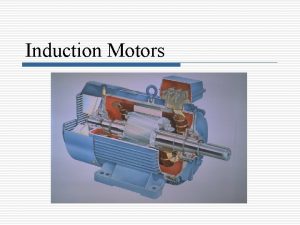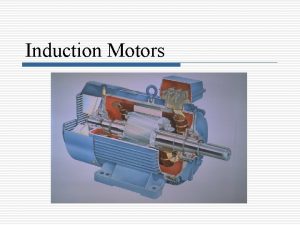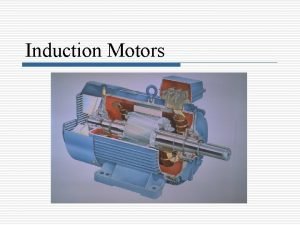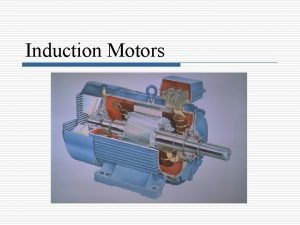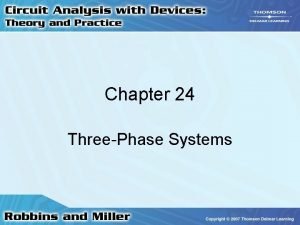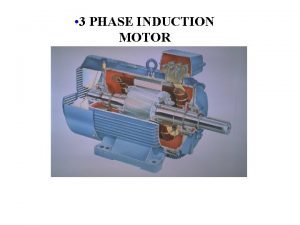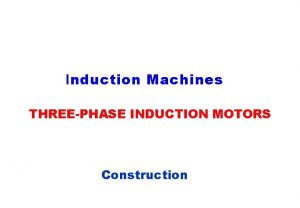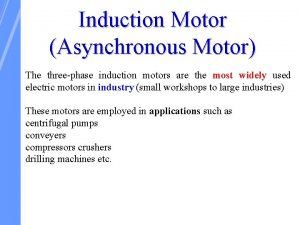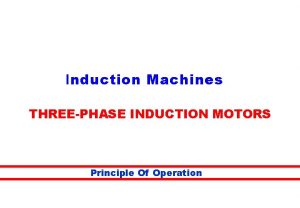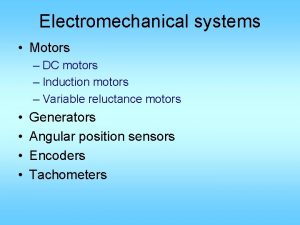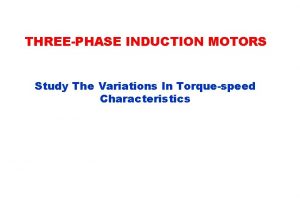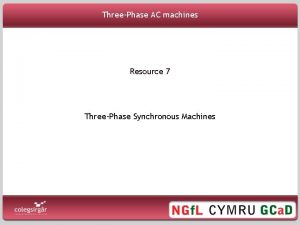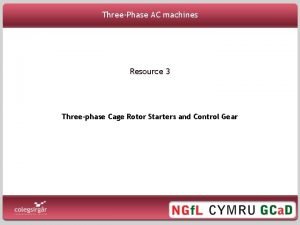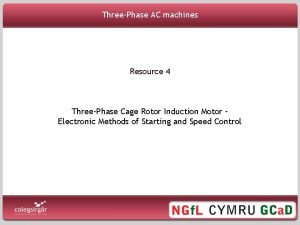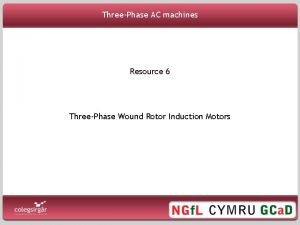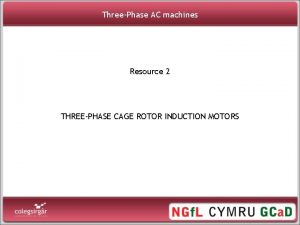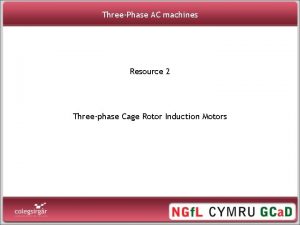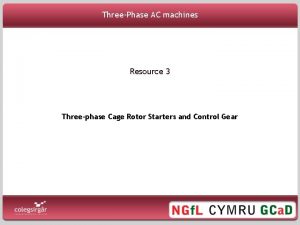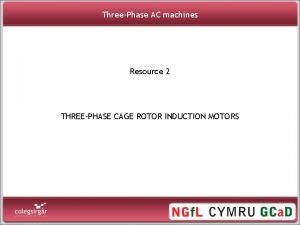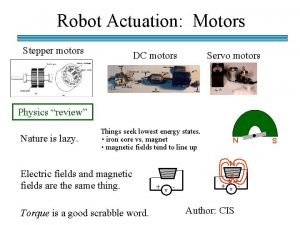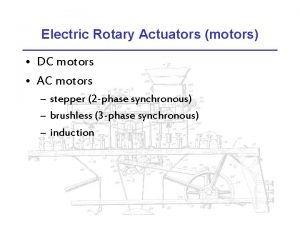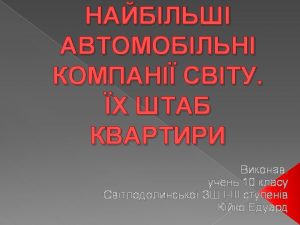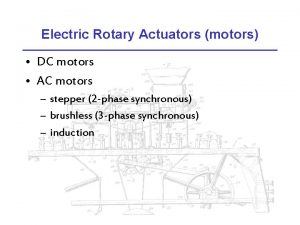Induction Motors Lecture 12 Introduction Threephase induction motors
































- Slides: 32

Induction Motors (Lecture 1&2)

Introduction Ø Three-phase induction motors are the most common and frequently encountered machines in industry - simple design, rugged, low-price, easy maintenance wide range of power ratings: fractional horsepower to 10 MW run essentially as constant speed from zero to full load speed is power source frequency dependent • • 11/24/2020 not easy to have variable speed control requires a variable-frequency power-electronic drive for optimal speed control EEE 1205, ME, KUET 2

Construction Ø An induction motor has two main parts - a stationary stator • • consisting of a steel frame that supports a hollow, cylindrical core, constructed from stacked laminations (why? ), having a number of evenly spaced slots, providing the space for the stator winding Stator of IM 11/24/2020 EEE 1205, ME, KUET 3

Construction - a revolving rotor • • composed of punched laminations, stacked to create a series of rotor slots, providing space for the rotor winding one of two types of rotor windings conventional 3 -phase windings made of insulated wire (wound-rotor) » similar to the winding on the stator aluminum bus bars shorted together at the ends by two aluminum rings, forming a squirrel-cage shaped circuit (squirrel-cage) Ø Two basic design types depending on the rotor design - squirrel-cage wound-rotor 11/24/2020 EEE 1205, ME, KUET 4

Construction Squirrel cage rotor Wound rotor Notice the slip rings 11/24/2020 EEE 1205, ME, KUET 5

Construction Slip rings Cutaway in a typical woundrotor IM. Notice the brushes and the slip rings Brushes 11/24/2020 EEE 1205, ME, KUET 6

Rotating Magnetic Field Ø Balanced three phase windings, i. e. mechanically displaced 120 degrees form each other, fed by balanced three phase source Ø A rotating magnetic field with constant magnitude is produced, rotating with a speed Where fe is the supply frequency and P is the no. of poles and nsync is called the synchronous speed in rpm (revolutions per minute) 11/24/2020 EEE 1205, ME, KUET 7

Principle of operation Ø This rotating magnetic field cuts the rotor windings and produces an induced voltage in the rotor windings Ø Due to the fact that the rotor windings are short circuited, for both squirrel cage and wound-rotor, and induced current flows in the rotor windings Ø The rotor current produces another magnetic field Ø A torque is produced as a result of the interaction of those two magnetic fields Where ind is the induced torque and BR and BS are the magnetic flux densities of the rotor and the stator respectively 11/24/2020 EEE 1205, ME, KUET 8

Induction motor speed Ø At what speed will the IM run? - - Can the IM run at the synchronous speed, why? If rotor runs at the synchronous speed, which is the same speed of the rotating magnetic field, then the rotor will appear stationary to the rotating magnetic field and the rotating magnetic field will not cut the rotor. So, no induced current will flow in the rotor and no rotor magnetic flux will be produced so no torque is generated and the rotor speed will fall below the synchronous speed When the speed falls, the rotating magnetic field will cut the rotor windings and a torque is produced 11/24/2020 EEE 1205, ME, KUET 9

Induction motor speed Ø So, the IM will always run at a speed lower than the synchronous speed Ø The difference between the motor speed and the synchronous speed is called the Slip Where nslip= slip speed nsync= speed of the magnetic field nm = mechanical shaft speed of the motor 11/24/2020 EEE 1205, ME, KUET 10

The Slip Where s is the slip Notice that : if the rotor runs at synchronous speed s=0 if the rotor is stationary s=1 Slip may be expressed as a percentage by multiplying the above eq. by 100, notice that the slip is a ratio and doesn’t have units 11/24/2020 EEE 1205, ME, KUET 11

Example 1 A 208 -V, 10 hp, four pole, 60 Hz, Y-connected induction motor has a full-load slip of 5 percent 1. 2. 3. 4. What is the synchronous speed of this motor? What is the rotor speed of this motor at rated load? What is the rotor frequency of this motor at rated load? What is the shaft torque of this motor at rated load? 11/24/2020 EEE 1205, ME, KUET 12

Solution 1. 2. 3. 4. 11/24/2020 EEE 1205, ME, KUET 13

Problem 2 11/24/2020 EEE 1205, ME, KUET 14

Equivalent Circuit 11/24/2020 EEE 1205, ME, KUET 15

Power losses in Induction machines Ø Copper losses - Copper loss in the stator (PSCL) = I 12 R 1 Copper loss in the rotor (PRCL) = I 22 R 2 Ø Core loss (Pcore) Ø Mechanical power loss due to friction and windage Ø How this power flow in the motor? 11/24/2020 EEE 1205, ME, KUET 16

Power flow in induction motor 11/24/2020 EEE 1205, ME, KUET 17

Power relations 11/24/2020 EEE 1205, ME, KUET 18

Equivalent Circuit Ø We can rearrange the equivalent circuit as follows Actual rotor resistance 11/24/2020 EEE 1205, ME, KUET Resistance equivalent to mechanical load 19

Power relations 11/24/2020 EEE 1205, ME, KUET 20

Torque-speed characteristics Typical torque-speed characteristics of induction motor 11/24/2020 EEE 1205, ME, KUET 21

Maximum torque Ø Maximum torque occurs when the power transferred to R 2/s is maximum. Ø This condition occurs when R 2/s equals the magnitude of the impedance Req + j (Xeq + X 2) 11/24/2020 EEE 1205, ME, KUET 22

Maximum torque Ø The corresponding maximum torque of an induction motor equals Ø The slip at maximum torque is directly proportional to the rotor resistance R 2 Ø The maximum torque is independent of R 2 11/24/2020 EEE 1205, ME, KUET 23

Maximum torque Ø Rotor resistance can be increased by inserting external resistance in the rotor of a wound-rotor induction motor. Ø The value of the maximum torque remains unaffected but the speed at which it occurs can be controlled. 11/24/2020 EEE 1205, ME, KUET 24

Maximum torque Effect of rotor resistance on torque-speed characteristic 11/24/2020 EEE 1205, ME, KUET 25

Problem 3 11/24/2020 EEE 1205, ME, KUET 26

Solution to Problem 3 11/24/2020 EEE 1205, ME, KUET 27

Problem 4 11/24/2020 EEE 1205, ME, KUET 28

Solution to Problem 4 11/24/2020 EEE 1205, ME, KUET 29

Solution to Problem 4 11/24/2020 EEE 1205, ME, KUET 30

Solution to Problem 4 11/24/2020 EEE 1205, ME, KUET 31

Reference: • http: //www. uwindsor. ca/users/n/nkar/88514. nsf/9 d 019077 a 3 c 4 f 6768525698 a 00593654/418 a 9 ccf 151 f 07 c 585256 e 24006 ac 51 c/$file /7_lecture_induction%20 motors. ppt Speed control and braking of induction motor------- Next Class 11/24/2020 EEE 1205, ME, KUET 32
 Induction motors procurement
Induction motors procurement 01:640:244 lecture notes - lecture 15: plat, idah, farad
01:640:244 lecture notes - lecture 15: plat, idah, farad Swot tata motors
Swot tata motors Introduction to electric motors
Introduction to electric motors Introduction to biochemistry lecture notes
Introduction to biochemistry lecture notes Introduction to psychology lecture
Introduction to psychology lecture Introduction to algorithms lecture notes
Introduction to algorithms lecture notes Motor equivalent circuit
Motor equivalent circuit Lisa gue
Lisa gue Wheel hub motors for automotive applications
Wheel hub motors for automotive applications Setting limits on dts gate motor
Setting limits on dts gate motor Lesson 6 dc generators and motors
Lesson 6 dc generators and motors Mashima motor
Mashima motor Podium motors
Podium motors General motors hierarchy
General motors hierarchy Agv stepper motors
Agv stepper motors Baa motors
Baa motors Electrical energy to mechanical energy
Electrical energy to mechanical energy Business strategy of tata motors
Business strategy of tata motors The information needed to identify lines and other symbols
The information needed to identify lines and other symbols Special purpose motors
Special purpose motors Disadvantages of servo motor
Disadvantages of servo motor Annajah motors
Annajah motors Annajah motors
Annajah motors Perm pmg-132 electric motor
Perm pmg-132 electric motor Abb ability™ smart sensor
Abb ability™ smart sensor Module 00105 introduction to construction drawings answers
Module 00105 introduction to construction drawings answers How everything
How everything Unit 18 application of motors
Unit 18 application of motors Scott koziol
Scott koziol General motors msds sheets
General motors msds sheets General motors financial analysis
General motors financial analysis Tvs advantage dms
Tvs advantage dms
